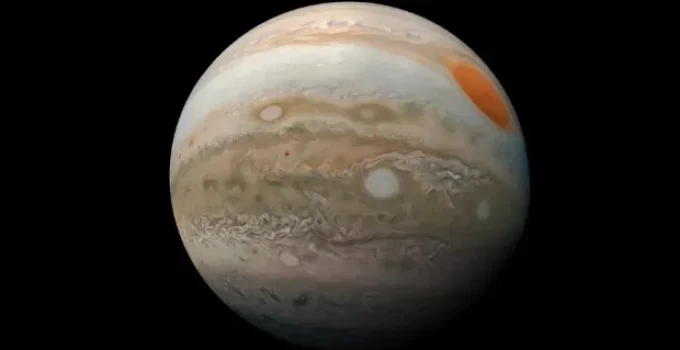What’s the Largest Planet in the Solar System?
Answer:
The largest planet in our solar system is Jupiter. It’s a massive gas giant that’s more than 11 times wider than Earth and ~ 318 times heavier. With its swirling storms, colorful bands, and powerful gravity, Jupiter is a true giant in every sense.
🚀 Dive Deeper
- How Big Is Jupiter Compared to Earth?
- What Is Jupiter Made Of?
- Why Is Jupiter So Big?
- What Makes Jupiter So Important?
- Final Thoughts
- References
How Big Is Jupiter Compared to Earth?
Jupiter is the fifth planet from the Sun and the first of the outer planets. But what really makes it stand out is its enormous size. Let’s compare:
- Diameter: Jupiter is about 86,881 miles (139,821 km) wide—11.2 times wider than Earth.
- Volume: You could fit more than 1,000 Earths inside Jupiter!
- Mass: Jupiter’s mass is ~318 times that of Earth, making it the most massive planet in the solar system.
Here’s a size comparison chart:
| Planet | Diameter (miles) | Mass (compared to Earth) |
|---|---|---|
| Earth | 7,918 | 1× |
| Jupiter | 86,881 | 318× |
| Saturn | 72,367 | 95× |
| Neptune | 30,599 | 17× |
| Mercury | 3,031 | 0.055× |
📊 Interesting Stat: According to NASA, Jupiter is 2.5 times more massive than all the other planets in the solar system combined.
What Is Jupiter Made Of?
Unlike Earth, Jupiter doesn’t have a solid surface. It’s mostly made of hydrogen and helium, the same gases found in stars. Deep inside Jupiter, the pressure is so intense that hydrogen turns into a liquid metal—something that doesn’t exist naturally on Earth!
Layers of Jupiter:
- Outer atmosphere: Colorful clouds made of ammonia and water
- Middle layer: Liquid hydrogen
- Core (possibly): Not solid. It’s partially dissolved, with no clear separation from the metallic hydrogen surrounding it.
It also has the strongest magnetic field of any planet in the solar system and dozens of moons orbiting it.
📊 Interesting Stat: According to NASA, “Jupiter’s enormous magnetic field is 16 to 54 times as powerful as that of the Earth.”
Why Is Jupiter So Big?
Jupiter became the largest planet because it formed in a region rich in gas and dust, far from the Sun. About 4.6 billion years ago, as the solar system was forming:
- The Sun’s gravity pulled material inward.
- Farther out, gases could clump together without being burned off.
- Jupiter’s core grew quickly and started grabbing more and more gas.
Scientists believe that Jupiter was the first planet to form, and it may have helped shape the orbits of other planets.
📊 Interesting Stat: Jupiter likely formed within 10 million years of the Sun’s formation—very early in the solar system’s history.
What Makes Jupiter So Important?
Jupiter does more than just float out there being big. It actually protects Earth in some ways:
- Its massive gravity acts like a vacuum cleaner, pulling in or deflecting comets and asteroids that might otherwise hit us.
- It helps stabilize the orbits of other planets.
- Its strong magnetic field traps radiation, which could help shield nearby moons.
Also, Jupiter’s moon Europa may have an ocean beneath its icy surface—one of the best places in the solar system to search for signs of life.
📊 Interesting Stat: Jupiter has 95 confirmed moons as of 2025, including the four largest called the Galilean satellites.
🎯 Final Thoughts
So, what’s the largest planet in the solar system? It’s Jupiter by far. With its massive size, powerful gravity, and swirling storms, it’s a planet like no other. Even though it’s made of gas, its effects on the solar system are solid—and essential.
Jupiter isn’t just a giant. It’s a protector, a laboratory, and a window into how planets form. And as we continue exploring it with missions like NASA’s Juno, we’ll keep learning more about this amazing gas giant.
📚 References
💻NASA Solar System Exploration. “Jupiter Overview.”
https://solarsystem.nasa.gov/planets/jupiter/overview
📝Helled, Ravit. “The Interiors of Jupiter and Saturn.” Oxford Research Encyclopedia of Planetary Science, June 2019, https://doi.org/10.1093/acrefore/9780190647926.013.175.
💻NASA Solar System Exploration. “Jupiter Facts.” https://science.nasa.gov/jupiter/jupiter-facts/
💻NASA Solor System Exploration. “Jupiter Moons.” https://science.nasa.gov/jupiter/jupiter-moons/
📝Jones, C. A. and R. Holme (2017), A close-up view of Jupiter’s magnetic field from Juno: New insights into the planet’s deep interior, Geophys. Res. Lett., 44, 5355–5359, doi:10.1002/2017GL074200.
📝Pollack, James B., et al. “Formation of the Giant Planets by Concurrent Accretion of Solids and Gas.” Icarus, vol. 124, no. 1, 1996, pp. 62–85. https://doi.org/10.1006/icar.1996.0190.
📝Batygin, Konstantin, and Fred C. Adams. “Determination of Jupiter’s Primordial Physical State.” arXiv, 19 May 2025, arXiv:2505.12652.
💻NASA Astrobiology Institute. “How Jupiter Got So Big.” https://astrobiology.nasa.gov/nai/articles/2001/5/7/how-jupiter-got-big
💻NASA. “Jupiter’s Moon Europa.” https://science.nasa.gov/jupiter/jupiter-moons/europa/
📌Learn More About the Planets
- Which Planet Could Humans Live On?🪐Searching for Our Second Home
- Which Planets Have Rings?🪐Saturn Is Not the Only Sky Princess
- What’s the Order of the Planets (—and Why)?🪐A Solar System Road Map
- What’s the Smallest Planet in the Solar System?🪐Tiny but Mightly in the Cosmic Lineup
- Why Does Mars Look Red? 🪐A Stunning Look at the Science of Rust in Space
